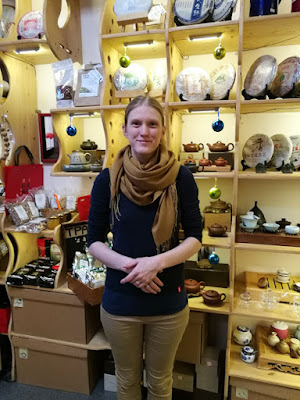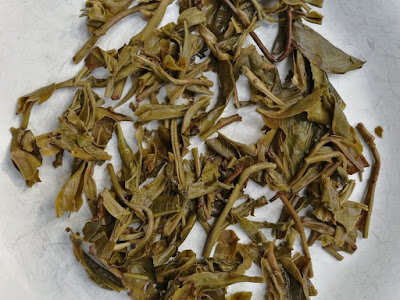Based on talking about pu'er online with Philip Lee, owner of
Yiwu Mountain Pu'er Tea, he generously offered to send some teas for review. In this case it's partly about supporting my exploration of sheng pu'er, probably as much as getting feedback about the product or whatever promotional value there is from mentioning products here.
One aspect of pu'er that I've not explored much yet is how aging changes specific teas. It typically takes time to gain exposure to that experience. No matter how much you try different teas of different ages, even relatively identical versions from different years, it's very difficult to place storage conditions variations related to other factors. You don't always know where those teas spent the prior years, and even relatively consistent annually produced teas could still vary related to minor condition variations.
Phillip sent a number of similar teas from different years (qiaomu origin pu'er from Yiwu, which refers to wild arbor trees). These were stored and therefore aged in similar conditions, so this should be a great chance to experience aging differences more directly. That's as good an alternative as is likely to come up, aside from owning cakes and drinking them year to year over a long time, and remembering back or reviewing notes to identify transition. I've bought a couple of sheng cakes in the past few months but I'm still not really doing justice to that standard project approach, and may never ramp it up to a relatively ordinary level.
Since I'll be trying a number of teas from them it seems as well to mention their background and the description of this set, starting with the
intro in their website:
Our Mission: provide authentic premium-quality Yiwu Mountain Tea and support the families of Yiwu
My wife's family is based in Gaoshan Village, Yiwu Mountain, Mengla county, Xishuangbanna. We currently operate a small family business in Guangzhou, selling authentic premium-quality Yiwu teas. This website was created to help support the sales of pure Yiwu-sourced teas to the global market, as our physical location focuses on local customers...
How it all began:
This business started with Mr Li Jia Cai, our father and a true local of Yiwu, who has been tending to the family tea plantations ever since he was a young boy. As the eldest son of his immediate family, he took responsibility for selling the family tea planted by his ancestors and this helped to build his reputation for sourcing organic, high-quality tea... To this day, most of our teas are still sourced by his local knowledge and immaculate ability to find great tea.
Sounds good; that's the kind of background one might hope to hear about. Onto a description of this sample set (which they do also sell as a commercial product offering, not exactly in the form of samples I received, but something comparable):
It is a very accessible set of teas, especially good for those relatively new to Puer and/or Yiwu. If you are relatively new to tea, this pack will help you learn more about specific characteristics of different Yiwu productions. If you are a more experienced tea drinker, you will still be able to learn more about our company products, clean Guangzhou ageing, and likely experience nuances about mouthfeel, cha qi and huigan, especially when compared to blended or non-Yiwu products.
The version he sent me includes all years from 2012 to 2017, so designed to really emphasize aging as an input, with
that sample set listed online including the following instead:
2017 Yiwu Qiaomu
2012 Yiwu Qiaomu
2017 Yiwu Gushu
2012 Yiwu Gushu
2015 Yiwu Huangpian
2016 Yiwu Ripe
Yiwu shou; that's different. The versions I have aren't gushu, matching those Qiaomu samples instead.
A couple of last details before moving onto tasting notes. Philip suggested paired tastings, which makes sense. It is possible to taste three or four teas at the same time but even with tasting two versus only one the detail of what you pick up can fall off. It gets to be a lot to take in. That really also depends on practice in doing comparison tastings, and how ideal the tasting environment is for focus, related to background noise and such. Tasting in a hurry doesn't really work either, at least not for tea that's not very straightforward or already very familiar.

Initially it looked as if there were two 2016 sample versions, based on my interpretation of the handwriting. The samples look like maocha, as if none of them were pressed, but in discussion with Philip the 2017 hasn't been pressed yet but all the others were. It seems they were carefully separated back out into loose tea again for distribution as samples, probably a little more broken than an unpressed maocha would be, but it's hard to notice that difference at a glance. Philip explained why this is possible related to the teas being hand pressed instead of machine pressed, and not as tightly compacted.
Next one might wonder if Guangzhou climate is wet or dry, related to other familiar storage locations (
with more graphs related to those other areas in this post).
Here's a chart (no graph turned up right away; this format will do).
Temperature variation is interesting (or relative lack of it), but humidity is more of a concern (66 to 84 as monthly averages). It doesn't look quite as consistently warm and damp as Malaysia but not so different than Hong Kong, still on the humid side, more humid, warmer, and more consistent than in Kunming.
 |
Tea storage areas throughout East and SE Asia (and where I am, BKK)
|
That one friend I keep referring to in Wuyishan just mentioned that it's right around zero (C) there for a daily low lately; odd it seems a little cooler being so close, based on noting Fujian just slightly to the North on that map. But local weather does depend on elevation and other factors.
Review, comparison tasting 2017 and 2016 Yiwu sheng:
 |
2016 left, 2017 right; lots of color difference
|
The 2017 sheng version experience is nice; bright, intense, and complex. The profile is as I generally expected from previous exposure to other Yiwu versions, not that I have sub-region and other variations completely mapped out. Floral range accounts for a lot of the taste, along with a strong mineral base that links with feel and aftertaste effect range (or at least seems to). The tea is intense while you drink it and the experience stays with you, the taste and feel not subsiding after swallowing it.
Astringency versus bitterness and feel can be an odd range of somewhat related aspects to describe for young sheng. That full feel is essentially the astringency of the tea coming across, and the apparent tie to mineral range flavors is a typical part of the experience. Sometimes it also relates to a taste of actual bitterness. Not so much in this case, but the experience is complex, so it does include just a little of that too. Sweetness and other aspect range makes it work; it balances. I'll get back to those next levels of detailed description across other infusions.
The 2016 version experience is quite different. There is some overlap, but a warmer, sweeter, richer range of tastes dominates. I was concerned this initial tasting would mostly point towards a likelihood of more significant change across more years (the ages of samples extends back to 2012), but that won't be the case. I wouldn't have expected this much change in a tea in one year. Of course there are going to be other factors since tea producers can't make exactly the same tea year to year, for lots of reasons.
 |
2016 left, 2017 right; slight color difference in brewed liquid as well
|
Before going further with similarities and differences, it occurs to me that there is a reason essentially no one gives clear, detailed, specific, meaningful review descriptions of teas (even me; the rambling on here doesn't necessarily count as an exception). Breaking down and describing the flavors requires interpretation, and the feel and other range all the more so. Even related to a relatively accurate, clear, complete description from an experienced, more-objective reviewer a different person with similar background and skills could easily interpret the same tea slightly differently, or perhaps even completely differently in terms of individual aspect-description sets.
I also suspect that it's a flawed premise underlying reviewing that a tea's flavors can meaningfully be reduced to 5 or so flavor elements. That's only true for that description being objectively accurate and complete; of course it can work to pass on a very descriptive impression, especially after a reader has tried some of the same teas as a reviewer to identify how those descriptions and interpretations match up. Enough reviewing philosophy aside; back to these teas.
The flavor range I would associate with sheng aging is apparent in the 2016 sample, or at least that's how I interpret it. The general flavor warmth is based on an aspect range that moves from bright floral and intense mineral a little towards a root-spice effect. It has softened and rounded out more than I'd expect possible in a year (again based on assuming a very similar starting point, which isn't a given). That did lead to trading off the brightness and sweetness, with the mineral layer intensity also softening.
It's a character trade for one type of appeal for another, and for many this second one year older version would be more approachable, even though I expect for most young sheng drinkers the 2017 sample already is that. I think maybe two years ago prior to more sheng exposure that would've been more true for me, that it would be easier to relate to the softer tea. Related to trying
a tuocha of Dayi pu'er I would guess is somewhat type-standard awhile back this 2017 version is very smooth and pleasant tasting, and that tea had been around for a few years already. It drifts into a subject I won't treat here but it's a given that tightly compressed teas--like that tuocha--age relatively slower. Of course the starting point had to be much different, since the comparison is with a very young tea (less than a year old) and a very slightly aged one, not yet into middle-age (3 years).
 |
next infusion (2016 left); again both bright with a slight color difference
|
The 2017 version softens a bit on the second infusion; I'd expect it will transition a bit more over the next couple. It's funny how softening and warming a little leads it to being so similar to the 2016 version on the first infusion. It still does retain more mineral in the flavor, and more brightness and freshness, and pronounced floral aspect. The aftertaste seems more pronounced for this version (in a sense I associate with hui gan, if I'm using that concept to map to an experience properly). I wouldn't be surprised if it is actually a slightly better version of tea than the other, and that's not just an age related factor, that aspect diminishing a little.
I think it's not just the flavor difference that makes the experience so dramatic, but also the feel, and not just related to some general level of fullness or astringency, also where the tea affects your mouth. The first you feel more in sides and rear of the mouth, and the part that lingers on, also on the rear of the tongue. This 2016 sample feel (and to some extent taste effect, it seems) is more pronounced in the middle of your tongue. I wouldn't naturally guess these two samples are from the exact same origin, if tasting them blind. Of course there are lots of other factors beyond growing conditions and plant types that go into how a tea turns out, with processing as much an input as those, or even more, according to some opinions I've ran across.
I accidentally went a bit longer on that next infusion, a bit over half a minute instead of more in the 15 to 20 second range (for once I didn't go overboard with proportion, keeping it in a more normal range, or I'd be on flash infusions instead). In general it seems to work to try the teas brewed very lightly to notice more about flavor aspects and more medium strength to focus on feel and aftertaste (just my impression; take that part for what it's worth).
The 2017 tea has softened enough in "opening up" that it's not bad at all slightly more intense, and for someone drinking the tea more to appreciate that feel and aftertaste intensity maybe this is actually optimum. The experience of the tea is still really pronounced a minute later. I've tried tea versions where that extends lots further, so that five minutes later it's still not really diminishing much, but this still seems significant.
To be honest it's not an aspect range I'm particularly attached to anyway. I sort of get why people learn to appreciate it, and why that's a common theme within strands of tea culture (often regionally based, leading into a longer story). But at the same time you have to learn to want to experience that, it seems to me, and that type of appreciation seems more a developed cultural aspect than a natural inclination, or one that develops naturally with experience. Then again I never really got why some experienced wine drinkers love French wines that taste like a nail was stored inside the bottle, back when I was into that. There was probably a natural preference transition going on I never did follow that interest far enough to appreciate, only moving from liking merlots and red zins into syrahs and different blends.
It would be nice if I could place that flavor range in the 2016 version better. It tastes like storage effect to me (fermentation, but an effect that varies with conditions), a very specific warming, softening, and flavor-range shift, but one that's hard to describe. Moving into a flavor like sassafrass is as good a description as I'll probably come up with, but it's not that simple. Extending into warmer mineral tone is also part of it, and the flavor complexity isn't describable in tasting like one thing, or even as a set. I'd expect that for either of these teas aged for a few more years (as in the 2012 and 2013 samples) I might still struggle with description but the transition would be so pronounced into a different range that more might come to mind. Or I might just continue to fail to capture what I mean by "warmer mineral" aspects instead. The one year older version kind of makes more sense brewed slightly stronger, to me, even if the feel and aftertaste don't match that range of experience in the other, or maybe because of that, because taste just intensifies but the rest still isn't as significant.
The next infusion sees both teas smoothing a bit but not transitioning much. It seems they're going to produce a lot of consistent infusions, which is a good sign, but really also just kind of what I'd expect. Both teas strike a really nice balance related to the prior described aspect range, and continued to do so for another half dozen rounds, with allowance for extending brewing time to keep infusion strength up.
 |
Thai demigods; unrelated filler photo
|
Conclusion:
They're nice teas. They're also just what I would have expected, and quite similar to the range experienced
in that Yiwu tasting event last year (a Ding Jia Zhai village area sheng pu'er vertical tasting, to be more specific). The difference in years (with one year of aging) is a lot more significant than I'd have expected, but trying other samples might inform if that was instead related to differences in tea versions as much as to one year of aging. It was a good start on tasting a range of different related teas, the first time I've ever experienced such a thing to this degree, or at least in a form anything like this.
These two samples raise as many questions as they answer, and trying the others should help cover some of them. I'm curious how aging will change the older samples, with the sequence going back to 2012. It will be interesting to see to what degree I can separate out any year-by-year variation from that input. I'm wondering what age / level of fermentation I'll prefer, or if it just doesn't work out that they're all different, with the variation more interesting than any one version.
Per some accounts sheng pu'er is said to typically age through a middle-age period where aspects flatten out, and then re-emerge in a different positive form later. How that cycle times out, or even how regularly that particular pattern holds, probably relates to both the starting point for aspects and personal preference for a particular range. Per another standard take pronounced bitterness and astringency are critical elements in brand new sheng that relate to aging potential, translating into aroma later. This samples tasting series won't be able to fill in background related to those sorts of issues, but it will be fascinating to experience more about how one approachable, pleasant version of Yiwu sheng changes across a number of years.

































































